Citizen Action
Another Win for Your Lake of Air
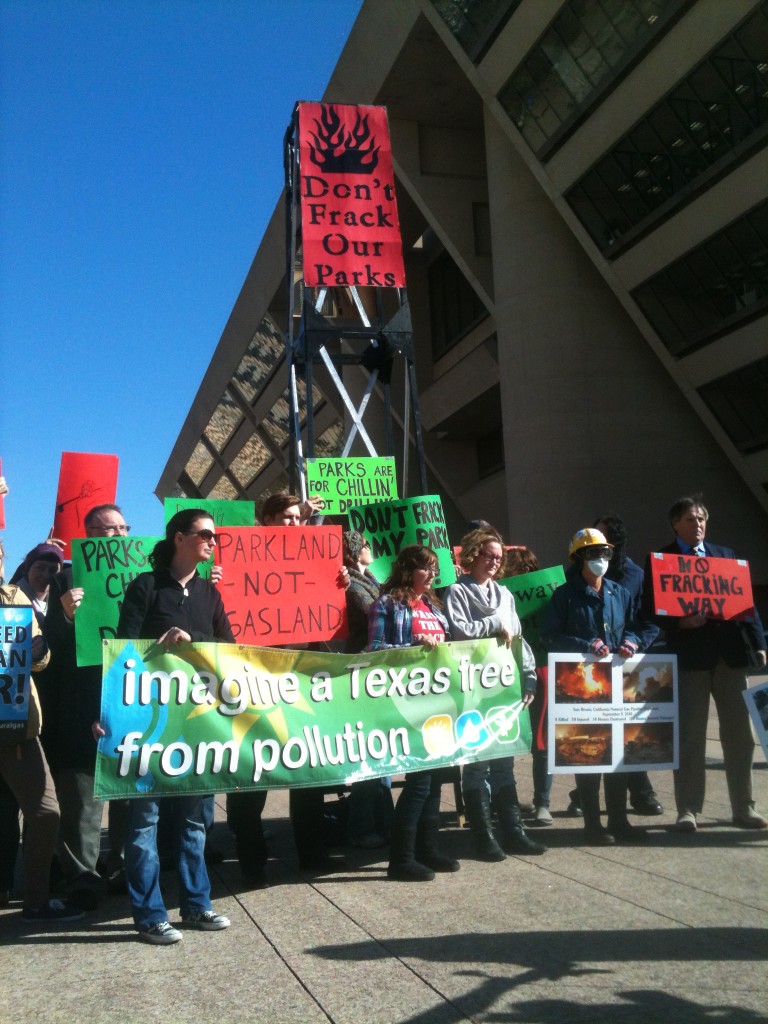 Late Thursday night Downwinders at Risk, as part of the Dallas Residents at Risk alliance, won a victory that citizens weren't supposed to win. Late Thursday night Downwinders at Risk, as part of the Dallas Residents at Risk alliance, won a victory that citizens weren't supposed to win.
Immediately after Thanksgiving, Dallas Mayor Mike Rawlings and City Manger Mary Suhm had plotted to speed the approval of the first gas drilling permit in Dallas. One left over from 2008 that would be exempt from the new drilling ordinance now in the works. One that included a compressor station and allowed for the drilling in city parks and flood plains. City Hall believed it had greased the tracks with threats of gas company lawsuits and given the City Plan Commission no choice but to approve the permit. Just to be sure, they scheduled the Plan Commission vote for December 20th, a time guaranteed to result in smaller crowds of opposition at City Hall. But something happened to make things go a little off-script. Responding to calls for help, enough Dallas residents showed up to articulately speak against the permit for more than an hour. They represented hundreds of neighborhood groups, the environmental community and public interest organizations like the League of Women Voters. If the raw numbers didn't match earlier attendance, the people that did show up represented real constituencies numbering in the thousands. When the vote was finally called at 7:30 pm Thursday evening, we won 7 to 5. The "grandfathered" gas drilling permit would not be approved by the Plan commission. To overturn this decision, the City Council must find 12 votes – a super majority – in favor of the permit at its mid-January meeting. This was not the result Dallas City Hall was counting on the Thursday night before Christmas. But thanks to supporters like you, it was the result that happened. Just as we mobilized opposition to Midlothian cement plant pollution, and helped organize Frisco residents to close down an obsolete and dangerous lead smelter, Downwinders is drawing a line in the Shale in Dallas and leading a push back against irresponsible urban drilling. And, against very long odds, we're winning….again. We do this to protect your lake of air. You ingest an average of 200 gallons of water every year, or about five bathtubs' worth. But you inhale approximately two million gallons of air every year – your own small lake of air.
In DFW, chances are your lake of air is going to have smog in it, along with some soot, some Sulfur Dioxide, Volatile Organic Compounds, as well as an assortment of other manufactured If your tap water was dirty brown and had lots of particles in it, you'd probably choose to drink bottled water. But when the air is dirty brown and has lots of particles in it, your lungs don't have a choice about the air they can use. Downwinders at Risk is here for one reason and one reason only: to defend your lake of air. Whether your air is threatened by smelters, gas rigs, cement plants or too-common smog, we're working to clean it up. For our efforts, Downwinders was proud to receive the first-ever GreenSource DFW award for Outstanding Grassroots Group in 2012. Looking ahead to 2013, your lake of air faces new threats, including worsening new permits by the Midlothian cement plants to burn large volumes of industrial garbage, and indiscriminate aerial spraying of pesticides by local governments. Downwinders at Risk will fight these threats with the combination of good science and citizen activism that's made us the foremost clean air group in DFW. But we need your help to do it. Our work depends on contributions from folks like you who appreciate what we do. Our annual budget is usually only around $30-50,000. We do all the work we do with an amount of money larger groups spend annually on office furniture or travel. We don't get money from a parent group in Washington or New York. Our board members are all from DFW. They're ordinary citizens like you, not rich patrons. Small donations make up a very large percentage of what we take in every year. We couldn't do what we do without you. In the time it took you to read this message, you've inhaled a couple of more gallons of air. Don't you think it should be clean air? You keep supporting us; we keep working for you – and surprising the opposition with victories that citizens in Texas just aren't supposed to be able to pull-off. That's our promise. Thanks for your consideration and Please click here to safely and securely donate online, or send checks to Downwinders at Risk, PO Box 763844, Dallas, TX 75376. Your donation is greatly appreciated and will be wisely spent. Thanks.
|
Good Friday: Exide Smelter Closing Today
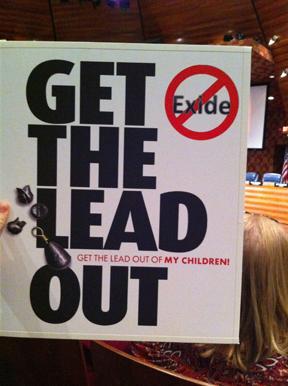 Sometimes, all it takes is the slightest push of an index finger, or a focused exhaling of breath.
Sometimes, all it takes is the slightest push of an index finger, or a focused exhaling of breath.
Sometimes the house of cards is so precarious, so unstable, that any challenge, no matter how slight, can send the established structure to the ground.
A year ago a small, newly-formed citizens group that had just staged its first action was struggling to convince the City of Frisco to quit supporting co-existence with an outlaw lead smelter and instead kick it out of town.
Today, that smelter will stop operating.
Community activism rarely pays off as quickly or as spectacularly as it has with the curious case of the Exide lead smelter. But when it does, it's reason to pause and give thanks and remind ourselves that such things are still possible.
Because truth be told, this historic effort was directed by a group of Frisco residents that was never larger than 10 people strong. Please just think about that. Less than a dozen people challenging their local status quo are responsible for this huge victory for public health.
Downwinders' often tells its supporters that, like the Woody Allen quote about life, 90% of social change is about just showing up. The system so often goes completely unchallenged, that you'd often be surprised what happens when you just show up and start asking embarrassing questions. When you start poking at the house of cards.
As their campaign proceeded, this small group of committed people attracted the support of hundreds, and then thousands of their fellow residents. They forced the city to see the contradiction between the continued operation of a circa-1960's smelter and the reality of 2012 Frisco. They held up a mirror and re-framed the relationship between smelter and town. And the contradiction was so great, so at odds with the new perception of Frisco, that the established political support the smelter had enjoyed in town for decades dried up. Young couples with kids concerned about a lead smelter they never heard of before outnumbered Good Ol Boys in City Hall and the Chamber of Commerce. The old establishment was undone by the very demographics of change they'd unleashed a decade or so earlier.
There is still much work to do. A half-century of contamination blankets the smelter site, as well as an undetermined number of off-site "hotspots." Exide wants to leave a permanent landfill behind in the middle of Central Frisco, while the City is breezing along with plans to turn a piece of land right across the street from the smelter site into the city's largest park. Downwinders will be helping citizens monitor the cleaning-up of the smelter site for at least the next two years.
But as of today there is no more lead pollution coming out of the Exide smokestacks. No more daily fallout of poison. No more new layers of lead being laid down in the topsoil of Frisco. That is a pretty remarkable thing considering where we were 365 days ago.
So raise your glasses tonight to the hardy folks of Frisco Unleaded and the improbability of the impossible happening in record time. Here's to Colette McCadden, Henrik Ax, Shiby Matthew, Matt Vonderahe, Jeannette Sandin, Meghan Green, and Eileen Canavan, all residents who decided they would stick their neck out and start showing up and asking questions, much to the consternation of the Powers That Be. May they all have Frisco parks, and schools, and streets named after them.
It's not always this easy, but the fact that it was this time should give us hope about the power of pushing back.
A “Solar Happy Hour” Tonight
 Because you haven't really partied until you've partied with clean energy advocates.
Because you haven't really partied until you've partied with clean energy advocates.
The Sierra Club, along with the Blue Green Apollo Alliance, and the Clean Energy Works for Texas coalition, is hosting what they're calling a Solar Happy Hour, TONIGHT where everyone concerned with increasing conservation, wind and other renewables can get together informally and listent to the latest.
WHEN: Thursday, November 29th at 7:00pm
WHERE: Picasso's Pizza (12300 Inwood Rd, Dallas, TX 75244)
FEATURING:
- Dave Cortez, Coordinator from the Blue Green Apollo Alliance, discussing the next steps on our clean energy campaign leading into the P.U.C Sunset Review and the 83rd Legislative Session
- Stephanie Cole, Organizing Representative from the Sierra Club, discussing a new Beyond Coal campaign being in launched in Dallas next spring
If you need more information, contact the intrepid Lisa Trope, one of the Greencorps staffers who've been organizing all fall around energy issues in DFW at Lisa@greencorps.org. As always, drink and think responsibly.
Hell Freezes Over: Why the New Federal Report on Midlothian Matters
Everything in italics and "quotation marks" below is a direct quote from the latest chapter of the ATSDR's (Agency for Disease Registry and Toxic Substances) "health consultation" on the impact of certain kinds of industrial air pollution on the local population.
You should take five minutes to glance over the sentences. They've taken a better part of a decade and a great deal of citizen persistence to make it to print. You can read them now only because of a petition to ATSDR by local Midlothian residents, spearheaded by Sal and Grace Mier in 2005, prompted the Agency to get involved.
They're also rarer than hen's teeth. Because the words actually come together in sentences to conclude human health was likely harmed by the pollution from Midlothian's three cement plants and steel mill, as well as recommend decreasing that pollution.
Among grassroots activists, ATSDR has a notorious reputation for issuing reports that are "inconclusive by design." The joke is that the agency never met a facility it couldn't learn to live with. And sure enough, previous chapters in this saga have disappointed. Just two years ago, ASTDR's shoddy work in investigating health impacts in Midlothian and elsewhere across the country was the subject of a Congressional hearing.
These ATSDR reports generate no new data. Instead, they are retrospective looks back at the available sampling/monitoring information and a piecing together of possible exposure paths and levels. As such, they're only as good as the data they can digest. In Midlothian's case, that means they're completely dependent on state monitoring – criticized by citizens for years as being inadequate. Nevertheless, with this latest report, citizens have been somewhat vindicated because of what even that inferior sampling revealed.
The health impacts described in this latest report are also limited to what are called "Criteria Pollutants" – old school substances like lead, soot, sulfur dioxide, and ozone that have been regulated by the Clean Air Act for decades. They do not apply to more exotic kinds of air pollution like endocrine disruptors, which there's little or no monitoring for at all.
So there are a lot of missing pieces, but the ATSDR's conclusions and recommendations have an impact on your lungs and maybe your own local fight, even if you don't have a Midlothian zip code. For the first time a federal agency known to avoid coming to any conclusion about anything was forced to say that human health was adversely affected by the operations of industry in Midlothian.
There's a public meeting on this report on December 6th from 7 to 8:30 pm at the Midlothian Conference Center.
Health Consultation/Assessing the Public Health Implications of the Criteria (NAAQS) Air Pollutants and Hydrogen Sulfide MIDLOTHIAN AREA AIR QUALITY MIDLOTHIAN, ELLIS COUNTY, TEXAS
NOVEMBER 16, 2012 U.S. DEPARTMENT OF HEALTH AND HUMAN SERVICES
Agency for Toxic Substances and Disease Registry
Division of Community Health Investigations
Recommendations:
"Texas Commission on Environmental Quality (TCEQ) should take actions to reduce future SO2 emissions from TXI to prevent harmful exposures."
"TCEQ should take actions to reduce future PM2.5 emissions from TXI and Gerdau to prevent harmful exposures."
"TCEQ should continue efforts to reduce regional ozone exposures."
"TCEQ should insure that levels of these air pollutants do not increase to levels of concern in the future."
"TCEQ should conduct ambient air monitoring to characterize exposures to persons located downwind of the Ash Grove and Holcim facilities and take actions to reduce SO2 emissions from these facilities if harmful exposures are indicated."
"TCEQ should conduct appropriate ambient air monitoring to characterize exposures to persons located downwind of the Ash Grove and Holcim facilities and take actions to reduce PM2.5 emissions from these facilities if harmful exposures are indicated. In addition, particulate matter monitoring is needed in residential areas that are in immediate proximity to the facilities’ limestone quarries."
"In ATSDR’s judgment, one notable gap in monitor placement is the lack of monitoring data for residential neighborhoods in immediate proximity to the four industrial facilities, where fugitive emissions (those not accounted for in stack emissions) likely have the greatest air quality impacts."
Human health was likely harmed, and is still threatened by industrial pollution from Midlothian
From Sulfur Dioxide:
"Breathing air contaminated with sulfur dioxide (downwind of TXI's cement plant and the Ameristeel steel mill) for short periods could have harmed the health of sensitive individuals.…ATSDR cannot determine if harmful exposures to SO2 have been occurring downwind of the Holcim and Ash Grove facilities."
"All 24-hour values in Midlothian were lower than EPA’s former standard. However, the World Health Organization’s health comparable guideline is 8 ppb (WHO, 2006). This value was exceeded at both the Midlothian Tower and Old Fort Worth Road stations in most years of monitoring through 2008…"
"Overall, in the years 1999 to 2001, Old Fort Worth Road (monitoring site north of TXI) ranked among the stations with the highest 24-hour average sulfur dioxide concentrations in the state. As sulfur dioxide emissions from TXI Operations decreased in following years, so did the measured concentrations at this station."
From Particulate Matter, or Soot:
"Public health concern is warranted for adverse health effects from long-term exposure to PM 2.5 in Cement Valley"
"In the past (1996–2008), annual average PM 2.5 levels measured were just below the range of concentration proposed by EPA for lowering the annual average standard…Moreover, many of the annual average PM 2.5 concentrations were above the more conservative WHO health guideline (10 μg/m3)."
"No PM 2.5 monitoring data are available to evaluate exposures downwind of the Ash Grove facility. Furthermore, although annual average PM2.5 levels detected at the Holcim monitor indicate possible harmful levels…."
"We estimated that annual average PM2.5 levels in the vicinity of the Gerdau Ameristeel monitor, from 1996 to 1998, could have ranged from about 22.6 to 26.4 μg/m3, which is above both the current and proposed EPA standard. Using EPA’s approach, the 3-year average level might have been above the NAAQS standard of 15 μg/m3 for these years in the vicinity of the Gerdau Ameristeel monitor. Applying this same approach to annual average PM10 data from other monitors suggests that PM 2.5 levels could have been close to the current and proposed PM2.5 standard, especially for the Wyatt Road, Old Fort Worth Road, Gorman Road, and Midlothian Tower monitors."
"Consistent with the other pollutants discussed earlier, the estimated annual PM 2.5 emissions listed for these facilities are among the highest for Ellis County and also rank high among industrial sources statewide."
From Lead:
"Past lead air exposures during the period 1993 to 1998, in a localized area just north of the Gerdau Ameristeel fence line, could have harmed the health of children who resided or frequently played in this area….In the mid-1990s, the lead levels measured in this area ranked among the highest lead concentrations measured statewide."
From Smog:
"Scientific studies indicate that breathing air containing ozone at concentrations similar to those detected in Midlothian can reduce lung function and increase respiratory symptoms, thereby aggravating asthma or other respiratory conditions. Ozone exposure also has been associated with increased susceptibility to respiratory infections, medication use by persons with asthma, doctor’s visits, and emergency department and hospital admissions for individuals with respiratory disease. Ozone exposure also might contribute to premature death, especially in people with heart and lung disease. School absenteeism and cardiac-related effects may occur, and persons with asthma might experience greater and more serious responses to ozone that last longer than responses among people without asthma."
"The Midlothian Tower site recorded ozone concentrations above the level of the NAAQS for several years (TCEQ, 2011b), and the Old Fort Worth Road site has been measuring ozone concentrations close to the level of the NAAQS. Based on the data from both monitors, from August 1997 to September 2011, the 8-hour EPA ozone standard has been exceeded 236 times."
From Breathing Multiple Pollutants:
"ATSDR believes that sufficient information exists to warrant concern for multiple air pollutant exposures to sensitive individuals, especially in the past….The ability of the scientific community to fully and quantitatively evaluate the health effects from the mixture of air pollutants people are exposed to is at least ten years away (Mauderly et al., 2010)……The current state of the science limits our ability to make definitive conclusions on the significance of simultaneous exposures to multiple criteria air pollutants. ATSDR’s conclusions are based on our best professional judgment related to our understanding of the possible harmful effects of air pollutant exposures in Midlothian and our interpretation of the current scientific literature; therefore, these conclusions are presented with some uncertainty."
From New Production:
"Reductions in SO2 levels in Cement Valley have occurred since late 2008 resulting in exposures to both sensitive individuals and the general public that are not expected to be harmful. These reductions may be caused, in part, by declining production levels at local industrial facilities. Future harmful exposures in Cement Valley could occur if production rises to at least previous levels and actions are not taken to reduce SO2 emissions."
Regulatory "Safe Levels" Very Often Aren't
"Past SO2 exposures were not above the Environmental Protection Agency (EPA) standard in place at that time but were above the current standard."
"Past lead air exposures were not above the EPA standard at that time but were above the current standard.…The scientific community now believes that the current standard (15 μg/m3) for fine PM (measured by PM2.5) is a better indicator of possible long-term health effects from PM exposures than was the former EPA annual average standard for PM10 (EPA, 2006b)."
An Idea Worthy of Our Consideration
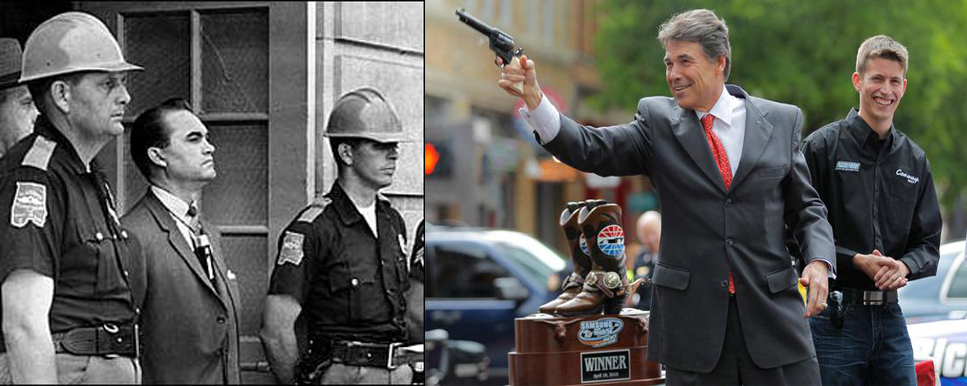 Under current law, EPA can designate states to enforce federal environmental laws if they, in fact, actually enforce the law and run competent programs. Once given by the EPA, rarely is this power taken away from a state.
Under current law, EPA can designate states to enforce federal environmental laws if they, in fact, actually enforce the law and run competent programs. Once given by the EPA, rarely is this power taken away from a state.
But when a state doesn't do a good job of enforcing the law or runs a program ineptly, the EPA considers taking back responsibility.That's happened recently in Iowa with the enforcement of the Clean Water Act. The Iowa Department of Natural Resources had been heavily criticized by state environmental groups for allowing huge CAFOs – Concentrated Animal and Feeding Operations to pollute the state's waterways. Beginning five years ago, they petitioned the EPA to take direct control of enforcing the Clean Water Act in Iowa. Their petition prompted an EPA investigation. The results confirmed the criticisms of the environmentalists and now the EPA is seriously thinking about stepping in.
Texas environmental groups should take note.
There is plenty of evidence on the public record to suggest Governor Perry and his Texas Commission on Environmental Quality are engaged in an active campaign of "nullification" of federal environmental laws just as Alabama Governor George Wallace was intent on negating federal civil rights legislation and rulings in the 1960's. But instead of standing in the schoolhouse door, Perry is using the world's second largest environmental agency to slow and obfuscate enforcement of the law in the name of his own over-the-top pro-industry agenda. The penalty for this kind of behavior 50 years ago was having the National Guard and Federal Marshals come into Alabama and make sure the law was followed. All we need in 2012 is for EPA to re-establish competent control over half a dozen federal environmental laws.
And if you don't think our Governor and his environmental agency are so nefarious as to construct a strategy to frustrate federal environmental law enforcement, what about stripping them of their responsibilities strictly because of their incompetence at administrating the federal programs. Take the last DFW air plan.…please. TCEQ kept insisting that the turnover of new cars on the road would almost singe-handedly produce the cleanest air in 25 years in North Texas. Not only was that forecast epically wrong – and off by a larger margin than the TCEQ's last clean air plan failure in 2007 – the plan actually left the region with dirtier air than when it began. It was bad science. Call this incompetence or call it incompetence by design. Either way, the result is the same. The Clean Air Act is not being effectively enforced by the state of Texas.
There are excellent reasons to believe that as long as Governor Perry and his TCEQ acolytes are making the decisions, DFW residents won't be able to breathe safe and legal air. It was obvious to many observers that needed pollution controls for industry didn't get included in the state's 2011 air plan for DFW because it would hinder the Governor's ability to raise money from this sector and it might appear to contradict his anti-regulatory political message. Rumor has it that Perry will run for Governor again in 2014 in order to re-position himself for another try at the Presidency in 2016. DFW's next clean air plan is due from the Perry TCEQ in….2015. As long as Perry has ambitions for higher office, your lungs are doomed
Along with trying to mobilize public opinion and rally local officials, maybe one thing DFW residents should be doing by way of self-defense is preparing a petition to EPA requesting it take over Texas' enforcement of the Clean Air Act.
2nd TCEQ Clean Air Plan in Four Years Fails, Leaves Air Dirtier
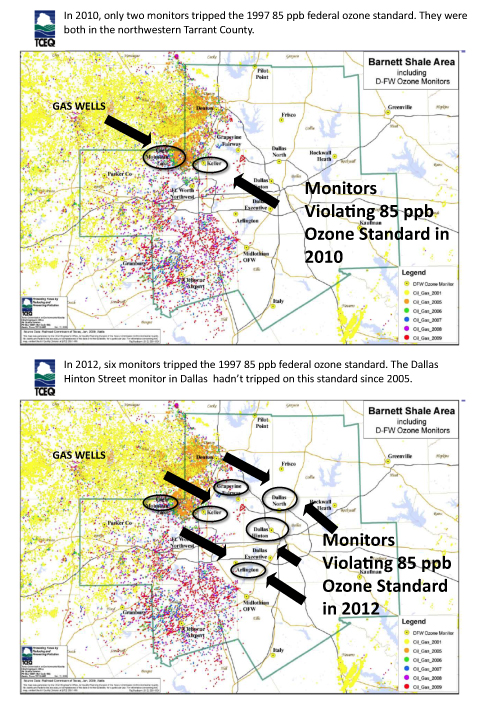 For the second time in four years a state-designed clean air plan to bring safe and legal air to DFW residents has failed, missing its goal by an even wider margin than on its first try, and leaving local air quality worse than when it started.
For the second time in four years a state-designed clean air plan to bring safe and legal air to DFW residents has failed, missing its goal by an even wider margin than on its first try, and leaving local air quality worse than when it started.
November 1st marked the official end of the eight-month 2012 ozone season. According to the Texas Commission on Environmental Quality, or TCEQ, its plan was supposed to deliver record-breaking clean air to DFW this summer on its way to bringing the region into compliance with the Clean Air Act for the first time in two decades.
Groups Petition EPA to Include Frackers in Toxic Release Inventory
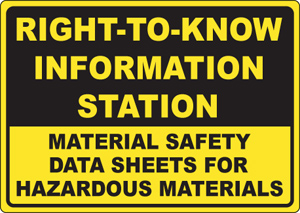 A dozen environmental and citizens groups filed a petition with EPA on Wednesday to close a loophole in the law and include oil and gas pollution in the annual system of self-reporting emissions and releases with which most US industrial polluters already have to comply.
A dozen environmental and citizens groups filed a petition with EPA on Wednesday to close a loophole in the law and include oil and gas pollution in the annual system of self-reporting emissions and releases with which most US industrial polluters already have to comply.
The Toxic Release Inventory, or TRI, was created in the wake of the horrible Union Carbide plant accident in Bhopal, India, that killed 2500 people immediately, and caused another 16,000 deaths in the months and years since. It's supposed to keep track of all hazardous and toxic chemicals on-site or released by industry at every facility regulated – power plants, cement plants, refineries, chemical plants of all kinds, lead smelters, etc. TRI numbers are self-reported once a year by the companies operating the facilities, based on EPA formulas. These numbers are then made available to the public via the EPA's own TRI Explorer site, or independent groups like RTK.net run by the OMB Watch folks.
However, the TRI leaves out a very large industrial segment – oil and gas drilling. This exemption might have made some sense 30 years ago, but it doesn't now, especially given the dramatic rise in modern-day fracking techniques that use large volumes of hazardous and toxic materials.
If EPA regulators went along, that would fold in not just drilling but also related activities at the wellhead, before oil and gas is ready for transport to customers and refiners. Under environmentalists’ petition, companies would be forced to report chemicals released in drilling and completing wells as well as compression operations and processing at fractionators that split gas into separate components.
Disclosures also would be required from hydraulic fracturing operations, in which mixtures of water, sand and chemicals are pumped underground to release natural gas and oil from dense rock formations.
Eric Schaeffer, director of the Environmental Integrity Project that spearheaded the campaign, stressed that the foundation of the TRI was a deeply held belief that the public has a right to know what kind of pollutants are being released from neighboring facilities.
We’re asking the EPA to “honor those values,” Schaeffer said. “EPA has the power to add other sectors that ought to be reporting, and we’re asking them today to exercise the authority.”
Jane Davenport, a senior attorney with the Delaware Riverkeeper Network, said the reporting mandate should apply broadly.
“The oil and gas industry should not get a pass from statutes that apply to other industries,” she said, noting that the industry already enjoys some exemptions from provisions in the Clean Water Act and other environmental laws.
This may not sound like a radical step, but don't discount the power of public disclosure. TRI numbers from the Midlothian cement plant helped Downwiders show that the kilns were the largest industrial and toxic polluters in North Texas, proved the companies were not telling the truth when they said there were no toxic emissions from waste-burning or cement-making, and allowed citizens to track the volumes of pollution coming out of the kilns and analyze those numbers for trends. That's why the oil and gas industry will be fighting tooth and nail to keep the loophole open. Even something as innocuous as disclosing your own chemical information is threatening to operations that have enjoyed historic protections from the public spotlight.
Coming Soon: Be You Own Air Monitoring Station
 When the Fukushima nuclear power plant disaster struck Japan last year, there was a lot of gaps in information about radiation levels, and a lot of public distrust with official pronouncements about those levels.
When the Fukushima nuclear power plant disaster struck Japan last year, there was a lot of gaps in information about radiation levels, and a lot of public distrust with official pronouncements about those levels.
As a way of getting around this, some entrepreneurs teamed up with software and hardware engineers and started building small portable Geiger counters that could be used by members of the public themselves. That's how the company Safecast was born. To date, the company's monitoring equipment has generated 4 million data points in Japan – reading that helped generate confidence about contamination levels.
After Fukushima, the company looked at other opportunities in the marketplace to fill a gap in consumer environmental health information. It decided that air quality reporting in the US and elsewhere suffered from a lot of the same problems as radiation reporting in Japan. The data is often licensed, unavailable, or just too slow to do much good. For example, the Texas Commission on Environmental Quality issues its "red" day ozone or smog alerts fully 2-3 hours after the first dangerous ozone readings are recorded at a local air monitor. You cannot get this information in real time – when it might do you and your children much more good.
Safecast plans to launch an effort that will more or less crowdsource air quality and fix that problem by giving real time, instantaneous information to users. It's a DIY approach to air pollution using the latest micro technology. The company hopes to create an international citizen-operated network of air quality monitors. It just received $400,000 from the Knight Foundation to work on prototypes and testing. All of the companies schematics will be available at no charge for easier distribution to citizens. Los Angeles is the first US city to get to use the new devices, but we'll be following their progress closely, hoping to bring this new grassroots effort to DFW, where we still suffer one of the nation's most serious and chronic smog problems.
Here’s to Rachael Carson: The First “Hysterical Housewife”
 50 years ago this month, Rachel Carson's Silent Spring was published and immediately created a national controversy. It's difficult to put the book in its true historical context now because we take so much of its message for granted, as well as the right of a woman scientist to get it published. But there's no question that in 1962 it was a very subversive act for many different reasons.
50 years ago this month, Rachel Carson's Silent Spring was published and immediately created a national controversy. It's difficult to put the book in its true historical context now because we take so much of its message for granted, as well as the right of a woman scientist to get it published. But there's no question that in 1962 it was a very subversive act for many different reasons.
There's an argument to be made that Carson didn't invent the modern American environmental movement. That it was the result of many different factors and people. All true. But there's also a compelling case that Carson's fight on behalf of her scholarship became the classic template for how citizens and industry and government would interact with each other in response to any environmental challenge coming from the grassroots for the next half-century.
Exhibit A: The New York Times Magazine piece this week on Carson. Consider:
1) She was the first to popularize the notion that we have a fundamental right to air and water that won't kill us.
“We are rightly appalled by the genetic effects of radiation. How then, can we be indifferent to the same effect in chemicals that we disseminate widely in our environment?
“If the Bill of Rights contains no guarantee that a citizen shall be secure against lethal poisons distributed either by private individuals or by public officials, it is surely only because our forefathers, despite their considerable wisdom and foresight, could conceive of no such problem.' She advocated for the birth of a grass-roots movement led by concerned citizens who would form nongovernmental groups that she called “citizen’s brigades.
As Carson saw it, the federal government, when in industry’s thrall, was part of the problem. That’s one reason that she didn’t call for sweeping federal regulation. Instead, she argued that citizens had the right to know how pesticides were being used on their private property."
2) She was the first to criticize our "modern" way of life as being self-destructive at a physiological level.
When she described the dangers of DDT and other pesticides, she described the threat as "poisons," not "chemicals."
“Silent Spring” was more than a study of the effects of synthetic pesticides; it was an indictment of the late 1950s. Humans, Carson argued, should not seek to dominate nature through chemistry, in the name of progress. In Carson’s view, technological innovation could easily and irrevocably disrupt the natural system."
As she finished the book, she was diagnosed with breast cancer. This gave her writing a more personal edge it probably would not have had otherwise. A biographer is quoted in the Times piece as saying, “She was more hostile about what arrogant technology and blind science could do."
“No one,” says Carl Safina, an oceanographer and MacArthur fellow who has published several books on marine life, “had ever thought that humans could create something that could create harm all over the globe and come back and get in our bodies.
Theo Colborn, an environmental health analyst and co-author of a 1996 book, “Our Stolen Future,” about endocrine disrupters — the chemicals that can interfere with the body’s hormone system — points out that Carson was on the cutting edge of the science of her day. “If Rachel had lived,” she said, “we might have actually found out about endocrine disruption two generations ago.”
3) She was the first to specifically identify young mothers as a key environmental demographic.
At a time when women were still second-class citizens and didn't have much economic clout, Carson specifically wrote in a way to get her female audience motivated to take action. She brought a moral message to what they were seeing in the everyday consequences of DDT use. Here's her writing about a squirrel killed by pesticides:
“The head and neck were outstretched, and the mouth often contained dirt, suggesting that the dying animal had been biting at the ground. By acquiescing in an act that causes such suffering to a living creature, who among us is not diminished as a human being?”
As the article points out, this was exactly the same kind of moral messaging that made Uncle Tom's Cabin the book that started and won the Civil War. Carson knew that women were the key to not only the DDT fight, but to every major environmental cause, and social justice movement. Next time you go to a grassroots environmental meeting or event, look around at the ratio of women to men and decide if she was wrong. Better yet, take a look at who the chemical industry is targeting with their advertising.
4) She was the first private citizen targeted for attack by the chemical industry.
This was the first time an entire industry specifically targeted a person for what they were writing and saying about the environmental and public health impacts of their product.
"Velsicol, a manufacturer of DDT, threatened to sue both Houghton Mifflin and The New Yorker. And it also tried to stop Audubon from excerpting the book in its magazine. The personal attacks against Carson were stunning. She was accused of being a communist sympathizer and dismissed as a spinster with an affinity for cats. In one threatening letter to Houghton Mifflin, Velsicol’s general counsel insinuated that there were “sinister influences” in Carson’s work: she was some kind of agricultural propagandist in the employ of the Soviet Union, he implied, and her intention was to reduce Western countries’ ability to produce food, to achieve “east-curtain parity.
The well-financed counterreaction to Carson’s book was a prototype for the brand of attack now regularly made by super-PACs in everything from debates about carbon emissions to new energy sources. “As soon as ‘Silent Spring’ is serialized, the chemical companies circle the wagons and build up a war chest,” Souder says. “This is how the environment became such a bitter partisan battle.”
In a move worthy of Citizens United, the chemical industry undertook an expensive negative P.R. campaign, which included circulating “The Desolate Year,” a parody of “A Fable for Tomorrow” that mocked its woeful tone. The parody, which was sent out to newspapers around the country along with a five-page fact sheet, argued that without pesticides, America would be overrun by insects and Americans would not be able to grow enough food to survive."
Does any of this sound familiar?
But her courage in the face of the industry's deluge gave others courage, and it still does so now. Think it's hard to do this work in 2012? Try taking on the Status Quo as a single woman with terminal cancer in 1962.
She didn't live long enough to see the multitude of legacies she left behind, but all of us are affected by them. Her call to arms produced the first real wave of popular environmentalism in the US that went by that name. Thanks Rachel.
Citizens Plan to “Shred” EPA at Cement Plant Rules Hearing
 WHAT: The Nation's Only Public Hearing on the EPA's Rollback of Cement Plant Air Pollution Standards
WHAT: The Nation's Only Public Hearing on the EPA's Rollback of Cement Plant Air Pollution Standards
WHEN: 9am to 7 pm Thursday, August 16th
WHERE: Arlington City Hall, 101 W. Abram
(Arlington)—Opponents of an EPA proposal to rollback new cement plant air pollution standards will incorporate a paper shredder into their comments at an all day national EPA hearing at Arlington on Thursday.
"Sometimes words aren't enough to express your outrage. You need an action that speaks louder. Our shredder is pretty loud," said Downwinders at Risk Director Jim Schermbeck, whose group is leading an effort to recruit 100 speakers to fill every 5-minute speaking slot from 9 an to 7pm.
He and others plan to use the shredder to show the EPA what's at stake in the agency's last-minute reversal of key parts of the first ever national toxic air pollution emission standards.
They're bringing pictures of relatives with pollution-related illnesses, copies of the Clean Air Act, health care bills, and the EPA's iconic logo to feed into the shredder to help drive home the personal and public effects of the agency's proposed two-year delay and increase in soot pollution.
"With this regulatory mugging, EPA is shredding air quality, it's shredding public health, its shredding public confidence. We're just showing the results," said Schermbeck.
Despite only 11 days notice for a national hearing in the middle of August, he predicts citizens will come close to meeting their goal of filling all available speaking slots. It's the only hearing EPA is holding as it considers the changes to the original federal 2010 cement plant pollution standards that were hailed by the same groups now protesting a retreat.
Groups are expected to be joined in their rejection of the rollback by North Texas area elected officials or members of their staff, including Congresswoman Eddie Bernice Johnson, State House Representative Lon Burnam, Dallas County Judge Clay Jenkins, prospective Congressional Representative Mark Veasey, and State Senator Wendy Davis.
In 2009, approximately 90 people testified at a similar DFW hearing as the rules were up for final adoption. Dallas-Ft. Worth is downwind of the nation's largest concentration of cement plant manufacturing, with three large plants located within only a few miles of each other in Midlothian. The plants have been the center of environmental and health controversies since the late 1980's and made North Texas a hotspot of citizen opposition to industry pollution.
Having finally been adopted after 20 years of lawsuits, the new emission standards were on their way to be singed into law by President Obama this summer when EPA suddenly pulled them and announced they wanted to delay implementation from next year to 2015 while also loosening emission standards for Particulate Matter pollution. In evaluating the results of the revision, EPA admitted it will increase PM pollution from the nations cement plants by 135 tons a year.
Previous EPA studies had calculated how many lives would be saved by the standards. Citizens have seized on these estimates to now calculate the harm of the agency's two-year delay, putting the national death toll at between 2-5,000 lives using the EPA's own numbers.
Because of the amount of pollution generated in Midlothian and the population density of DFW, a significant portion of those deaths will be local residents.
No court ordered the after-the-fact revisions. In fact, the rules had survived their very last court challenge last December. Schembeck says that makes the rollback even more mysterious.
"EPA is going out of its way to deny citizens what they were on the verge of winning – the first ever federal air pollution standards for the nation's cement plants," Said Schermbeck. "They're robbing people who've been working on this issue for over 20 years for no good reason. We're not going to be quiet as they try to take away what we've rightfully earned."

